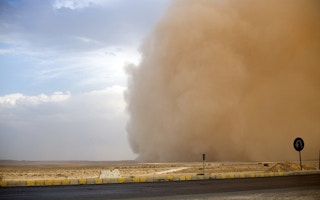A new study shows desert dust over the Arabian Sea, West Asia and the Arabian Peninsula can increase the intensity of the Indian summer monsoon rains and makes a case for detection and measurement of dust for better rain forecasts.
Dr. V. Vinoj, assistant professor at the Indian Institute of Technology (IIT) Bhubaneswar, and colleagues at the Pacific Northwest National Laboratory in the US, studied satellite data and analysed global climate model simulations. Their analysis indicates that by heating the atmosphere, dust particles cause winds over North Africa and the Arabian Peninsula, sending more moisture over India within a week.
The new findings published in Nature Geoscience add to scientists’ efforts to understand how aerosols (fine particles or liquid droplets in the air) can influence rainfall patterns in unexpected ways, with changes in one location rapidly affecting weather thousands of miles away.
Monsoon rain is the lifeline of South Asia. “Even slight changes (plus or minus 10 per cent) in the rainfall from the long term mean would mean either flood or drought; and the Indian economy even today is largely dependent on agriculture. Therefore it is very important that we understand all possible factors that may influence the strength of monsoon both in short and long time scales,” Vinoj said.
There is little understanding of how aerosols influence the monsoon on a global scale. “This uncertainty is due to its several complicated pathways through which it affects climate.” Vinoj explained. “On a regional scale such uncertainties becomes even more critical.” Understanding aerosols effect on weather and climate requires further study: what they look like, what they are made of and how they interact with light and with other substances in the atmosphere.
One of the rare efforts to measure and study aerosols over the Indian subcontinent is being carried out by the Indian Space Research Organisation‘s Aerosol Radiative Forcing over India (ARFI) network.
“A number of studies have focused on the role of anthropogenic aerosols like soot (which absorbs sunlight leading to a warming) and sulphate (which reflects sunlight back to space leading to a cooling) on the monsoon. These aerosols are pollution products from energy production, transportation, cooking and agricultural burning,” said Dr. Philip J. Rasch, chief scientist for Climate Science at the Pacific Northwest National Laboratory and a co-author of the new paper.
“
Even slight changes (plus or minus 10 per cent) in the rainfall from the long term mean would mean either flood or drought; and the Indian economy even today is largely dependent on agriculture. Therefore it is very important that we understand all possible factors that may influence the strength of monsoon both in short and long time scales
Dr. V. Vinoj, assistant professor at the Indian Institute of Technology Bhubaneswar
Role of dust on monsoon overlooked
“Most studies of the impact of aerosols on the monsoon have focused primarily on anthropogenic (human-generated) aerosols, although it is well known that natural aerosols such as dust and sea salt dominate over regions such as the Arabian Sea,” said professor Sulochana Gadgil, a monsoon expert based at the Indian Institute of Science (IISc) in Bangalore.
Dust plays a more important role than aerosols produced by humans, such as soot, because there is far more of it according to professor J. Srinivasan, chairperson of the Divecha Centre for Climate Change at IISc. If soot particles get deposited on dust then it will enhance the influence of dust, he said.
Previous studies have also largely focused on local impacts of aerosols over a longer period of time. “For example, most studies have explored how aerosols emissions that started in the spring might influence rainfall in the summertime,” Rasch said. “The new study, instead, probed rapid effects of natural aerosol changes on climate quite far away.
Srinivasan suggests scientists re-examine previous work on the impact of both natural and anthropogenic aerosols in order to understand the monsoon better. Most weather forecast models have not taken the influence of dust into account until recently, Srinivasan said. “If weather forecast models include dust their short term forecast of rainfall will improve.”
A brief history of haze
Given its importance for accurate forecasts, the impact of aerosols on Indian rains has sometimes led to controversy. A 1999 US-led initiative, the Indian Ocean Experiment (INDOEX), collected field data on the regional cooling effect of sulphate and other aerosols.
The scientists noted that soot from wood stoves and smokestacks hovering over the southern foothills of the Himalayas can reduce the monsoon rains. They used the term Asian Brown Cloud to describe the brown haze of aerosols over South Asia and the seas around it during January to March, after the rains.
Based on these findings a 2002 UNEP report talked about multiple impacts of a “vast blanket of pollution” on health, farming and climate on a regional and global scale. However, scientists criticised the report for its sensational tone.
Srinivasan and Gadgil wrote in the journal Current Science that: “the model simulation of the rainfall patterns over this region is particularly poor and hence the reliability of this projection is suspect.” The article also criticised a related UNEP press release for “blaming the developing nations in Asia for the pollution of the planet.” In response, in a follow-up study, the haze was renamed as Atmospheric Brown Cloud.
More than a decade later, getting an accurate monsoon forecast remains the holy grail of the region’s scientific community. ”Some of our earlier comments about models not simulating the monsoon realistically remain true even today…” Gadgil said. “Clearly more work is needed for deeper understanding of monsoon-aerosol interactions that will make it possible to generate reliable predictions of the impact of increased aerosols.”










